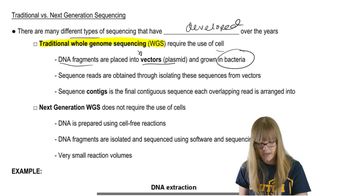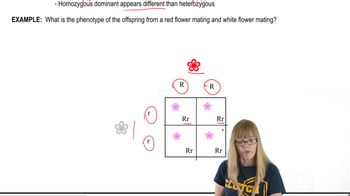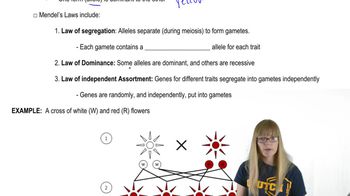Table of contents
- 1. Introduction to Genetics51m
- 2. Mendel's Laws of Inheritance3h 37m
- 3. Extensions to Mendelian Inheritance2h 41m
- 4. Genetic Mapping and Linkage2h 28m
- 5. Genetics of Bacteria and Viruses1h 21m
- 6. Chromosomal Variation1h 48m
- 7. DNA and Chromosome Structure56m
- 8. DNA Replication1h 10m
- 9. Mitosis and Meiosis1h 34m
- 10. Transcription1h 0m
- 11. Translation58m
- 12. Gene Regulation in Prokaryotes1h 19m
- 13. Gene Regulation in Eukaryotes44m
- 14. Genetic Control of Development44m
- 15. Genomes and Genomics1h 50m
- 16. Transposable Elements47m
- 17. Mutation, Repair, and Recombination1h 6m
- 18. Molecular Genetic Tools19m
- 19. Cancer Genetics29m
- 20. Quantitative Genetics1h 26m
- 21. Population Genetics50m
- 22. Evolutionary Genetics29m
2. Mendel's Laws of Inheritance
Mendel's Experiments and Laws
Problem 3a
Textbook Question
For the retinal cancer retinoblastoma, the inheritance of one mutated copy of RB1 from one of the parents is often referred to as a mutation that produces a 'dominant predisposition to cancer.' This means that the first mutation does not produce cancer but makes it very likely that cancer will develop.
What is the genotype of a normal cell in the retina in a person who has sporadic retinoblastoma? What is the normal cell genotype if the person has hereditary retinoblastoma? Explain the reason for the difference between the genotypes.
 Verified step by step guidance
Verified step by step guidance1
Understand that retinoblastoma is a type of cancer that can be caused by mutations in the RB1 gene, which is a tumor suppressor gene.
In sporadic retinoblastoma, both copies of the RB1 gene in a retinal cell must acquire mutations for cancer to develop. Therefore, the genotype of a normal retinal cell in a person with sporadic retinoblastoma is homozygous for the normal RB1 gene (RB1+/RB1+).
In hereditary retinoblastoma, an individual inherits one mutated copy of the RB1 gene from a parent. Thus, the genotype of a normal retinal cell in a person with hereditary retinoblastoma is heterozygous (RB1+/RB1-), where RB1- represents the mutated allele.
The difference in genotypes arises because, in hereditary retinoblastoma, the individual is born with one mutated allele, predisposing them to cancer, whereas in sporadic cases, both mutations occur somatically.
This concept is often explained by the 'two-hit hypothesis,' where two genetic 'hits' or mutations are required to inactivate both copies of a tumor suppressor gene, leading to cancer development.
Recommended similar problem, with video answer:
 Verified Solution
Verified SolutionThis video solution was recommended by our tutors as helpful for the problem above
Video duration:
1mPlay a video:
Was this helpful?
Key Concepts
Here are the essential concepts you must grasp in order to answer the question correctly.
Genotype and Phenotype
Genotype refers to the genetic constitution of an organism, specifically the alleles present at a given locus. In the context of retinoblastoma, a normal cell in the retina would typically have two functional copies of the RB1 gene (homozygous wild-type). The phenotype, which is the observable trait, is influenced by the genotype, and in the case of retinoblastoma, the presence of mutations in the RB1 gene can lead to cancer development.
Recommended video:
Guided course

Gamete Genotypes
Sporadic vs. Hereditary Retinoblastoma
Sporadic retinoblastoma occurs due to random mutations in the RB1 gene, typically requiring two mutations (one in each allele) in a single retinal cell for cancer to develop. In contrast, hereditary retinoblastoma is caused by inheriting one mutated copy of the RB1 gene, which predisposes the individual to cancer, as the second mutation can occur in any retinal cell, leading to tumor formation more readily.
Recommended video:
Guided course

Traditional vs. Next-Gen
Dominant Inheritance
Dominant inheritance means that only one copy of a mutated gene is sufficient to express a trait or predisposition to a condition. In the case of retinoblastoma, inheriting one mutated RB1 gene from a parent leads to a dominant predisposition to cancer, as the normal function of the gene is compromised, increasing the likelihood of developing tumors in the retina.
Recommended video:
Guided course

Variations on Dominance

 8:06m
8:06mWatch next
Master Mendel's Experiments with a bite sized video explanation from Kylia Goodner
Start learningRelated Videos
Related Practice



